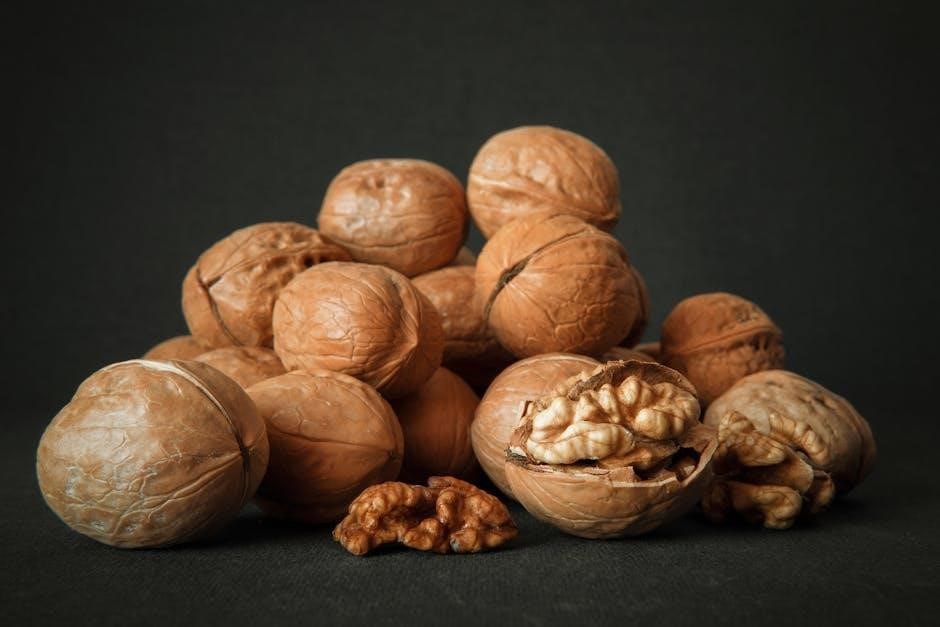Magnesium is an essential mineral crucial for bone health, muscle function, and energy production. It supports nerve function, sleep, and over 300 enzymatic reactions. Many people lack sufficient magnesium, making dietary sources vital for maintaining optimal health and preventing deficiency-related issues. Include magnesium-rich foods like dark leafy greens, nuts, seeds, and whole grains in your diet to ensure adequate intake.
Overview of Magnesium as a Essential Mineral
Magnesium is a macromineral essential for human health, playing a critical role in over 300 enzymatic reactions. It supports bone mineralization, muscle contraction, and nerve function, while also aiding in energy production and sleep regulation. As a key electrolyte, magnesium helps maintain fluid balance and nerve function. Despite its importance, many individuals fail to meet daily magnesium requirements, leading to potential health issues. Found abundantly in natural foods, magnesium is a vital nutrient that ensures proper bodily functions and overall well-being. Incorporating magnesium-rich foods into the diet is crucial for preventing deficiencies and maintaining optimal health.
The Role of Magnesium in the Human Body
Magnesium is a vital mineral that supports numerous bodily functions. It strengthens bones by aiding calcium absorption and regulates muscle contractions, preventing cramps and spasms. Magnesium also plays a key role in nerve function, enabling effective communication between nerves and muscles. It aids in energy production by activating ATP, the body’s energy currency, and supports glucose metabolism, helping regulate blood sugar levels. Additionally, magnesium promotes relaxation, improving sleep quality and reducing stress. It also supports immune function and heart health by maintaining healthy blood pressure and rhythm. Overall, magnesium is indispensable for maintaining physical and mental well-being, making it a cornerstone of a healthy diet.
Why Magnesium-Rich Foods Are Crucial for Health
Magnesium-rich foods are essential for maintaining optimal health due to their role in supporting vital bodily functions. Magnesium deficiency can lead to issues like muscle cramps, fatigue, and sleep disturbances, while adequate intake promotes energy production, nerve function, and bone strength. These foods help regulate blood sugar levels, support heart health, and enhance mental well-being by reducing stress and anxiety. Incorporating magnesium-rich foods into your diet ensures proper nutrient absorption and prevents deficiency-related complications. They are also linked to improved sleep quality and better overall physical and mental performance, making them a cornerstone of a balanced and healthy lifestyle.
Top Magnesium-Rich Food Categories
Top magnesium-rich food categories include seeds, nuts, legumes, whole grains, dark leafy greens, fatty fish, dairy, fruits, soy products, and dark chocolate, offering diverse and balanced nutrition.
Seeds: Pumpkin, Chia, and Sunflower Seeds
Seeds are among the richest sources of magnesium, with pumpkin seeds leading as one of the highest. Chia seeds and sunflower seeds also provide significant amounts. These seeds are not only packed with magnesium but also offer fiber, antioxidants, and healthy fats, supporting digestion and heart health. Pumpkin seeds, for instance, contain about 150 mg of magnesium per ounce, making them an excellent addition to salads or snacks. Chia seeds, known for their omega-3 content, also contribute to bone health and energy production. Sunflower seeds are versatile and can be enjoyed roasted or sprinkled on yogurt. Incorporating these seeds into meals is a simple way to boost magnesium intake naturally.
Nuts: Almonds, Cashews, and Brazil Nuts
Nuts are a delicious and convenient source of magnesium, with almonds, cashews, and Brazil nuts being among the richest. Almonds provide approximately 80 mg of magnesium per ounce, while cashews and Brazil nuts offer similar benefits. These nuts are also rich in healthy fats, protein, and antioxidants, making them a nutritious snack. Almonds support heart health and digestion, while cashews are known for their creamy texture and versatility in recipes. Brazil nuts, though higher in calories, are a good source of selenium and magnesium. Incorporating a handful of these nuts into your daily diet can significantly contribute to meeting your magnesium needs while offering additional health benefits.

Legumes: Black Beans, Chickpeas, and Lentils
Legumes are a powerhouse of magnesium, making them a vital component of a healthy diet. Black beans, chickpeas, and lentils are among the richest sources, with a single cup of cooked black beans providing approximately 120 mg of magnesium. These legumes are also packed with fiber, protein, and antioxidants, supporting overall nutrition. Magnesium in legumes helps maintain bone health, muscle function, and energy production. Incorporating legumes into meals like soups, salads, or stir-fries can enhance magnesium intake. Additionally, they are versatile and can be paired with various grains or vegetables for balanced nutrition. Legumes are a sustainable and nutritious way to meet daily magnesium requirements while offering numerous other health benefits.
Whole Grains: Quinoa, Brown Rice, and Oats
Whole grains like quinoa, brown rice, and oats are excellent sources of magnesium, offering numerous health benefits. Quinoa is particularly rich, with about 150 mg of magnesium per cup, while brown rice and oats provide around 80-100 mg per serving. These grains are also high in fiber, vitamins, and minerals, making them a nutritious addition to meals. Magnesium in whole grains supports energy production, nerve function, and muscle relaxation. Incorporating these grains into your diet can help maintain healthy blood pressure and bone strength. They are versatile and can be used in salads, as side dishes, or as a base for meals, ensuring a steady intake of this essential mineral.
Dark Leafy Greens: Spinach, Swiss Chard, and Kale
Dark leafy greens like spinach, Swiss chard, and kale are rich in magnesium and essential nutrients. Spinach provides approximately 80 mg of magnesium per cup, while Swiss chard and kale offer similar benefits. These greens support bone health, muscle function, and energy production. They also contain antioxidants and fiber, promoting overall well-being. Magnesium in these vegetables helps regulate blood pressure and supports nerve function. Incorporating cooked or raw dark leafy greens into meals can enhance magnesium intake. However, oxalates in spinach may slightly reduce absorption, so balancing with other magnesium-rich foods is beneficial. These versatile greens are ideal for salads, smoothies, or sautéed dishes, making them a nutritious addition to a balanced diet.
Fatty Fish: Salmon, Mackerel, and Halibut
Fatty fish like salmon, mackerel, and halibut are excellent sources of magnesium, offering approximately 60-70 mg per 3-ounce serving. These fish are also rich in omega-3 fatty acids, which support heart health and brain function. Magnesium in fatty fish helps regulate blood pressure, supports muscle and nerve function, and contributes to energy production. Salmon and mackerel are particularly high in magnesium, making them a nutritious choice for boosting intake. Incorporating fatty fish into meals can enhance overall health while providing essential nutrients. They are versatile and can be grilled, baked, or added to salads, making them a delicious and magnesium-rich addition to a balanced diet.

Dairy Products: Milk, Yogurt, and Cheese
Dairy products like milk, yogurt, and cheese are good sources of magnesium, providing approximately 30-40 mg per cup. Milk is a versatile option, while yogurt offers additional probiotics for gut health. Cheese, though lower in magnesium, still contributes to daily intake. These products are also rich in calcium and protein, supporting bone and muscle health. Incorporating dairy into meals can help meet magnesium needs, especially for those with higher dietary requirements. Low-fat or fortified options are excellent choices for maximizing nutrient intake without excess calories. Dairy products are a tasty and nutritious way to boost magnesium levels as part of a balanced diet.
Fruits: Bananas, Avocados, and Figs
Fruits like bananas, avocados, and figs are excellent sources of magnesium, offering a sweet and nutritious way to boost intake. Bananas provide about 32 mg of magnesium per medium fruit, making them a convenient snack. Avocados are particularly rich, with a medium avocado supplying around 59 mg, along with healthy fats and fiber. Figs, both fresh and dried, are another good option, with dried figs containing higher magnesium content. These fruits are versatile, adding magnesium to smoothies, salads, or eaten as standalone snacks. Incorporating them into meals helps maintain healthy muscle and nerve function while supporting overall well-being. They are also packed with vitamins and antioxidants for added health benefits.
Soy Products: Tofu, Tempeh, and Edamame
Soy products like tofu, tempeh, and edamame are excellent magnesium-rich foods, making them a great option for plant-based diets. Tofu is a versatile and protein-rich food, providing approximately 70 mg of magnesium per 100 grams. Tempeh, a fermented soybean product, offers similar benefits with about 110 mg of magnesium per 100 grams. Edamame, or boiled soybeans, are another high-magnesium option, delivering around 99 mg per 100 grams. These soy products are not only rich in magnesium but also in fiber, protein, and other essential nutrients. Incorporating them into meals supports muscle function, bone health, and energy production, while also promoting a balanced and nutritious diet.

Dark Chocolate and Cocoa Powder
Dark chocolate and cocoa powder are delicious and rich sources of magnesium, making them a unique addition to a healthy diet. Dark chocolate with at least 70% cocoa contains approximately 150 mg of magnesium per 100 grams, while cocoa powder provides around 130 mg per 100 grams. Both are also packed with antioxidants and flavonoids, which support heart health and reduce inflammation. Magnesium in dark chocolate and cocoa powder helps regulate muscle function, nerve function, and energy production. Moderation is key due to their calorie content, but incorporating small portions can be a tasty way to boost magnesium intake while enjoying potential cognitive and cardiovascular benefits.

Other Magnesium-Containing Foods
Besides the primary sources, vegetables like broccoli, carrots, and sweet potatoes, along with meats such as chicken, beef, and turkey, also contain magnesium. Fortified cereals and plant-based milk are additional options, providing essential nutrients for overall health and mineral balance.
Vegetables: Broccoli, Carrots, and Sweet Potatoes
Broccoli, carrots, and sweet potatoes are excellent vegetable sources of magnesium, offering a range of health benefits. Broccoli is particularly rich in magnesium, containing about 39 mg per 100 grams, and is also packed with vitamins C and K, which support bone health and immune function. Carrots, while lower in magnesium, provide vitamin A and antioxidants that promote eye health and reduce inflammation. Sweet potatoes are a good source of magnesium, with approximately 34 mg per 100 grams, and are also high in fiber and vitamins A and C, making them a nutrient-dense choice for overall well-being. Incorporating these vegetables into meals can help boost magnesium intake naturally.

Meat: Chicken, Beef, and Turkey
Chicken, beef, and turkey are moderate sources of magnesium, contributing to a balanced diet. Chicken breast contains about 25 mg of magnesium per 100 grams, while beef offers around 29 mg. Turkey provides similar amounts, making these meats a decent option for those seeking magnesium. They also supply high-quality protein, vitamins B6 and B12, and minerals like iron and zinc. While not the richest in magnesium, incorporating lean cuts of these meats can help meet daily requirements. Pairing them with magnesium-rich plant-based foods enhances overall nutrient intake, supporting muscle function, nerve health, and energy production. Moderate consumption of these meats is recommended for a well-rounded diet.

Fortified Foods: Cereals and Plant-Based Milk
Fortified cereals and plant-based milk are excellent sources of magnesium, especially for those with dietary restrictions or preferences. Many breakfast cereals are enriched with magnesium to help meet daily nutritional needs. Plant-based milks, such as almond, soy, and oat milk, are often fortified with magnesium, calcium, and vitamins, making them a nutritious alternative to dairy. These foods are particularly beneficial for individuals who may struggle to obtain enough magnesium from whole foods alone. Fortified options can help bridge the gap and prevent deficiencies. Always check the nutrition label to ensure the product contains adequate magnesium levels. These foods are versatile and can be easily incorporated into meals or snacks for a magnesium boost.

Factors Affecting Magnesium Absorption
Oxalates and phytates in foods can bind to magnesium, reducing absorption. Cooking and processing may also lower magnesium content in certain foods, impacting overall intake efficiency.
Oxalates and Phytates in Foods
Oxalates and phytates are naturally occurring compounds in foods that can interfere with magnesium absorption. Spinach, for instance, contains oxalates, which bind to magnesium in the gut, reducing its absorption. Similarly, phytates, found in whole grains and legumes, can inhibit magnesium uptake. These compounds are not inherently harmful but can significantly impact nutrient availability. Cooking or soaking foods may help reduce phytate content, enhancing magnesium absorption. While these foods are nutrient-rich, understanding their interaction with magnesium is key to optimizing dietary intake. Balancing these foods with others low in oxalates and phytates can help maintain adequate magnesium levels. Awareness of these compounds is essential for maximizing nutritional benefits.
The Impact of Cooking and Processing
Cooking and processing can significantly affect magnesium content in foods. Boiling or overcooking can lead to a loss of magnesium, as it dissolves in water. For example, boiling spinach can reduce its magnesium content by up to 30%. Steaming, however, helps retain more magnesium. Processing methods, such as milling whole grains into refined flour, remove the magnesium-rich germ and bran. Similarly, canning or excessive heat treatment can degrade magnesium. On the other hand, certain processes, like sprouting or fermenting, may enhance magnesium bioavailability. To maximize magnesium intake, it’s best to consume foods raw or minimally processed and opt for whole, unrefined options whenever possible. Balancing cooking methods is key to preserving this essential nutrient.
Dietary Tips for Maximizing Magnesium Intake
Incorporate a variety of magnesium-rich foods like seeds, nuts, whole grains, and dark leafy greens into meals. Pair with vitamin D to enhance absorption for optimal health benefits.

How to Incorporate Magnesium-Rich Foods into Meals
Start by adding magnesium-rich seeds like pumpkin or chia to breakfast oatmeal or yogurt. Include nuts such as almonds or cashews as snacks or salad toppings. Incorporate whole grains like quinoa or brown rice into main dishes. Dark leafy greens like spinach or kale can be blended into smoothies, sautéed as sides, or added to salads. Legumes such as lentils or black beans are great in soups or stews. Pair magnesium-rich foods with vitamin D sources to enhance absorption. Aim to diversify your meals with these foods to meet daily magnesium needs and support overall health.
Understanding Daily Recommended Intake
The daily recommended intake of magnesium varies by age and gender, with adults typically needing 400-420 mg per day. Women during pregnancy may require slightly more. The current Daily Value (DV) for magnesium is set at 420 mg, serving as a benchmark for dietary planning. Meeting this intake is crucial to avoid deficiency, which can lead to muscle cramps, fatigue, and sleep disturbances. Foods like dark leafy greens, nuts, seeds, and whole grains are excellent sources to help achieve this goal. Consulting a healthcare provider or dietitian can provide personalized recommendations based on individual needs and health status.
Magnesium is vital for health, and many people lack sufficient intake. Incorporating magnesium-rich foods like dark leafy greens, nuts, and seeds supports overall well-being and prevents deficiency.
Magnesium-rich foods are essential for maintaining optimal health. Key sources include seeds like pumpkin and chia, nuts such as almonds and cashews, and legumes like black beans and lentils. Whole grains, including quinoa and brown rice, are also excellent choices. Dark leafy greens like spinach and kale, fatty fish such as salmon, and dairy products like milk and yogurt provide significant magnesium. Fruits like bananas and avocados, soy products like tofu, and dark chocolate are additional rich sources. Incorporating these foods into your diet ensures adequate magnesium intake, supporting bone health, muscle function, and energy production. A balanced diet with these foods helps prevent deficiency and promotes overall well-being.
The Importance of a Balanced Diet for Magnesium

A balanced diet is crucial for ensuring adequate magnesium intake, as it supports overall health and prevents deficiency. Magnesium plays a key role in energy production, nerve function, and bone health, making it essential to consume a variety of magnesium-rich foods. Dark leafy greens, nuts, seeds, whole grains, legumes, and dairy products are excellent sources. A diverse diet helps meet daily magnesium needs, reducing the risk of deficiency-related issues like muscle cramps and fatigue. Incorporating these foods into meals ensures optimal nutrient absorption and supports long-term well-being. A balanced approach to nutrition is vital for maintaining magnesium levels and promoting a healthy lifestyle.
